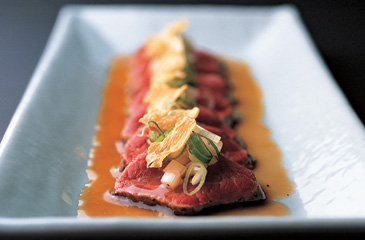
Beef Tataki
- 5 Tbsp. soy sauce
- 1/2 cup rice vinegar
- 1/3 cup dried bonito flakes*
- Ice cubes
- 7 ounces tenderloin of beef
- Freshly ground black pepper
- Vegetable oil , for deep-frying
- 2 or 3 cloves garlic , thinly sliced
- 2 Tbsp. thinly sliced green onion
Have ready a bowl of ice water. Season the beef with black pepper and heat a dry nonstick skillet until very hot. Sear each surface of the beef for 5 seconds, ensuring all sides are completely seared and no red meat is visible. Plunge the beef into the ice water to stop the cooking process. Remove, pat dry with paper towels and chill in the refrigerator.
Bring about 3/4 inch of oil in a saucepan to 300° and slowly deep-fry the garlic slices until they turn a light golden brown. Remove immediately and drain on paper towels.
Thinly slice the beef (1/16- to 1/8-inch thick) and arrange the slices on a flat serving dish.
Top each slice of beef with a little of the green onion and a slice of fried garlic. Spoon some of the sauce around the edges of the beef and serve.
*Bonito Flakes: Filleted bonito is steamed, dried, smoked and cured with a mold (Aspergillus glaucus). When the fillets have become as hard as a piece of wood, they are shaved. This whole process takes many months. The flakes are used to make dashi and as a flavoring and garnish in numerous other dishes. In fact, dried bonito flakes are necessary in one way or another for making every Japanese meal. They are called katsuobushi in Japanese.










